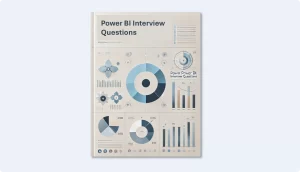
Power BI has become a cornerstone in the world of data analytics and business intelligence. If you’re preparing for a Power BI interview, it’s essential to be well-versed with the key concepts and tools that this powerful platform offers. Below are the top 10 Power BI interview questions that can help you ace your next interview.
1. What is Power BI, and how does it work?
Why it’s asked: This question tests your foundational knowledge of Power BI.
Answer: Power BI is a business analytics tool developed by Microsoft that enables users to visualize data and share insights across an organization or embed them in an app or website. It connects to various data sources, transforms raw data into meaningful insights, and allows users to create interactive dashboards and reports.
2. Explain the components of Power BI.
Why it’s asked: Interviewers want to assess your understanding of the Power BI ecosystem.
Answer: Power BI consists of several components, including Power BI Desktop (for report creation), Power BI Service (for sharing and collaboration), Power BI Mobile (for on-the-go access), and Power BI Gateway (for connecting on-premises data sources). Other components include Power BI Report Server and Power BI Embedded.
3. What are the different types of filters in Power BI?
Why it’s asked: Filters are a core feature in Power BI, and understanding them is crucial.
Answer: Power BI offers several types of filters: Visual-level filters (affecting individual visuals), Page-level filters (affecting all visuals on a page), and Report-level filters (affecting all pages in the report). Additionally, there are Drillthrough filters and Cross-report filters.
4. How do you handle performance optimization in Power BI?
Why it’s asked: Performance is key in large datasets, and this question gauges your ability to optimize.
Answer: Performance can be optimized by using best practices like reducing the data model size, minimizing the use of complex DAX expressions, using aggregations and calculated columns judiciously, and ensuring efficient data refreshes. Also, choosing the appropriate visualizations and avoiding unnecessary calculations can improve performance.
5. What is DAX, and how is it used in Power BI?
Why it’s asked: DAX (Data Analysis Expressions) is a fundamental part of creating custom calculations.
Answer: DAX is a formula language used in Power BI, Power Pivot, and SQL Server Analysis Services to create custom calculations in your data models. It includes functions, operators, and constants that are used to perform data analysis and calculations. Examples include SUM, AVERAGE, and CALCULATE.
6. Can you explain the difference between Power BI Desktop and Power BI Service?
Why it’s asked: Understanding the workflow between these two is crucial for effective Power BI use.
Answer: Power BI Desktop is primarily used for creating reports and data models. Power BI Service, on the other hand, is a cloud-based platform where these reports can be published, shared, and collaborated on. Power BI Desktop is installed on your computer, while Power BI Service is accessible via the web.
7. How do you create relationships between tables in Power BI?
Why it’s asked: Relationships are vital in creating a coherent data model.
Answer: Relationships between tables can be created in Power BI by using the “Manage Relationships” option. You can define one-to-one, one-to-many, or many-to-many relationships based on the data. Power BI also supports active and inactive relationships, which can be managed through the Relationship view.
8. What is Power Query, and how is it different from DAX?
Why it’s asked: Understanding the difference between data transformation and calculation tools is key.
Answer: Power Query is used for data transformation and preparation before it is loaded into Power BI, while DAX is used for data modeling and analysis once the data is in Power BI. Power Query is more about ETL (Extract, Transform, Load), whereas DAX focuses on calculations within the data model.
9. How do you perform data visualization best practices in Power BI?
Why it’s asked: Effective visualization is at the heart of Power BI.
Answer: Best practices include using appropriate chart types, keeping visualizations simple, using color effectively, ensuring consistency, providing context with titles and labels, and always considering the end-user’s perspective. Visuals should tell a story and provide insights at a glance.
10. What are some common challenges you’ve faced with Power BI, and how did you overcome them?
Why it’s asked: This question allows interviewers to see how you solve problems and handle challenges.
Answer: Common challenges include data refresh issues, performance bottlenecks, and managing large datasets. Overcoming these challenges involves understanding the underlying data model, optimizing DAX calculations, and ensuring that data is clean and well-structured before it is imported into Power BI.
Download Power BI Templates
Get a head start on your next Power BI project with a template and canvas blueprint.
